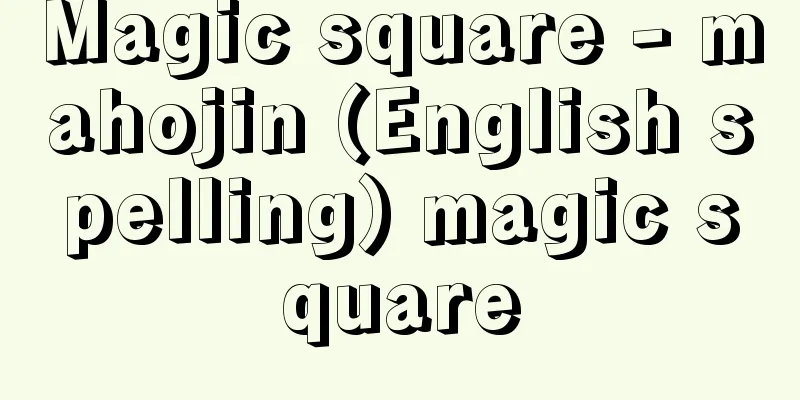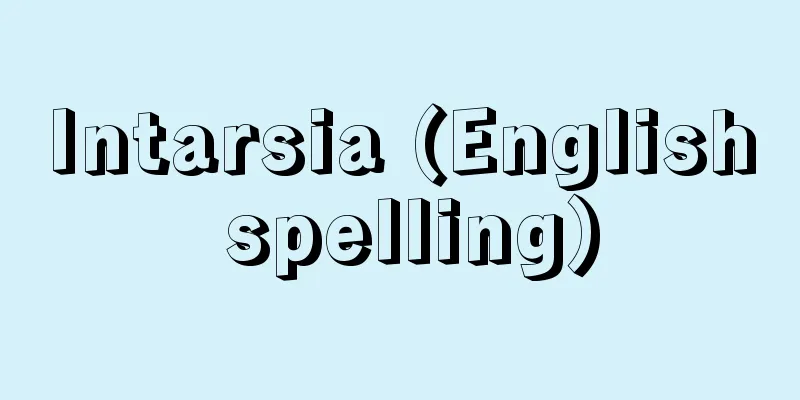Magic square - mahojin (English spelling) magic square

|
Also called a magic square. A magic square is a square that has n × n squares and the sum of the n numbers in each row, vertically, horizontally, and diagonally is constant. This n is called the order, and if n is 3 it is called a triangular square, and if n is 4 it is called a quadrangular square. Since a quadrangular square cannot be made, the smallest is the triangular square in There are songs to help remember triangular squares, such as "Don't hate (294) Shichigosan (753), and don't let the bee (8) sting you ( 61 ) monk. " In addition, the sum of the numbers in one row is 15 for a magic square, 34 for a quadrangular square, 65 for a pentagonal square, and 111 for a hexagonal square, and generally n ( n 2 +1)/2 for an n -square square. It is unclear when magic squares first appeared, but it is certain that they have been known in China since ancient times. Legend has it that when Yu, who later became the founder of the Xia dynasty, was carrying out flood control work on a river called Luo Shui, a large turtle appeared on its back with a pattern as shown in If the continuous circles in this pattern are rearranged into the number that corresponds to each number, it becomes a triangular square as shown in This magic square is therefore called the "Luo Shu." The existence of the Xia dynasty has not yet been confirmed, and the veracity of this story is uncertain, but if it is all true, it would date back approximately 4,000 years ago. Although this is left unclear, it seems safe to assume that triangular squares existed at least in China 2,000 years ago. Magic squares are now merely objects of mathematical puzzles, but they appear to have been extremely mystical to people in the past, and in China they were used as a form of divination known as the Nine Star Astrology. Magic squares were also used as talismans and protection from evil in Arabia and India. In the West, medals engraved with a person's zodiac sign and magic square were also used as talismans. shows a square depicted in a copperplate engraving entitled "Melancholy" by the famous German painter Dürer, which is also interpreted as having astrological meaning. The bottom row of this magic square shows the year of its creation, 1514 (in bold). Among magic squares, there are some that have various characteristics. is called a perfect square. If this magic square is rolled horizontally or vertically into a cylindrical shape and the top and bottom or left and right sides are overlapped, four diagonals are created on each side, for a total of eight diagonals. In a perfect square, the sums of the numbers of all these diagonals are the same. For example, Next, a parent-child square is like that shown in In this ten-squared square, the inside of each thick line is a magic square. In other words, this square is a ten-squared square, but it can also be an eight-squared square, a six-squared square, or a four-squared square. All the magic squares introduced so far have been flat. However, we can also consider magic squares in three dimensions. This is called a cubic magic square. In the case of a flat magic square, the elements are the numbers 1 through n2 , but in the case of a cubic magic square , the elements are the numbers 1 through n3 . Strictly speaking, for a cubic magic square, the length, width, top and bottom, planar diagonal (diagonal), and cubic diagonal must all be equal, but normally it is not necessary for the planar diagonals to be equal. In , Vertical: 8 + 22 + 12 = 27 + 14 + 1 = 42, etc. Horizontal: 8 + 13 + 21 = 9 + 14 + 19 = 42, etc. Top and bottom: 8 + 10 + 24 = 3 + 14 + 25 = 42, etc. Cube diagonal: 12 + 14 + 16 = 4 + 14 + 24 = 42 The first person to create such a cube was the famous mathematician Fermat. Fermat created a cube in 1640. However, in this work the cube's diagonal does not hold. Yoshihiro Kurushima was the first to create a cube with a diagonal that also holds. In addition to magic squares using numbers from 1 to n2 and 1 to n3 , many other magic squares have been created. Among them, prime number squares, which are made only of prime numbers, have been studied by many people since they were first discussed by British mathematical puzzle researcher H. E. Dewdney (1857-1930) in 1900. is one example. [Shigeo Takagi] "Study of Squares by Akira Hirayama and Rakuho Abe (1983, Osaka Kyoiku Tosho)" ©Shogakukan "> Triangular formation (Figure A) ©Shogakukan "> A pattern that is said to be the basis for the "Rakushu" (Illustration) ©Shogakukan "> Dürer's square (Figure C) ©Shogakukan "> Perfect square (Figure D) ©Shogakukan "> Parent-child square (Figure E) ©Shogakukan "> 3D square (Figure F) ©Shogakukan "> Prime Number Square (Figure G) Source: Shogakukan Encyclopedia Nipponica About Encyclopedia Nipponica Information | Legend |
|
方陣ともいう。n×n個の升目に数を入れて、縦、横、斜め、どの1列のn個の数の和も一定になるようにしたもの。このnを次数といい、nが3なら三方陣、nが4なら四方陣というようによんでいる。二方陣はつくれないので、の三方陣が最小のものになる。三方陣には、「憎(にく)し(294)と思うな七五三(753)、六一(61)坊主にハチ(8)が刺す」などの覚え歌がある。また、1列の数の和は、1からn2までの数を入れた普通の魔方陣では、三方陣が15、四方陣が34、五方陣が65、六方陣では111、一般にn方陣ではn(n2+1)/2である。 魔方陣がいつごろからあったかは不明であるが、中国で古くから魔方陣が知られていたことは確かである。伝えによると、のちに夏(か)王朝の始祖となった禹(う)が、洛水(らくすい)という河の治水工事をしたときに、背中にのような模様のついた大きなカメが現れたという。この模様のひとつながりの丸を、それぞれの個数に相当する数に置き直してみると、の三方陣になる。そこでこの魔方陣を「洛書(らくしょ)」とよんでいる。夏王朝の存在がまだ確認されていないうえ、この話の真偽もさだかではないが、すべてが事実だとすれば、約4000年前のことになる。このことはあいまいとしているが、少なくとも中国では2000年前には三方陣が存在していたと考えても間違いないようである。 魔方陣は、現在では数学パズルの対象でしかないが、昔の人にはよほど神秘的なものに映ったらしく、中国ではこれを基に九星術という占いがつくられた。また、アラビアやインドでも、魔方陣を御守りや魔除(まよ)けに使っていた。西洋でも、その人の星座と魔方陣とを刻んだメダルを御守りに用いたことがある。は、ドイツの著名な画家デューラーの『メランコリー』と題する銅版画のなかに描かれている四方陣も占星術的な意味があると解釈される。なお、この魔方陣のいちばん下の段には、製作年度の1514が示されている(太字で示す)。 魔方陣のなかには、いろいろな特色をもつものがある。は完全方陣とよばれるものである。この魔方陣を横または縦方向に筒形に丸めて、上下または左右の辺を重ねると、それぞれ4本ずつ、計8本の対角線が生じるが、完全方陣ではこれらの対角線の数の和もすべて等しくなる。たとえば、 次に親子方陣というのはのようなもので、この十方陣ではぞれぞれの太線の中が魔方陣として成り立つ。つまりこの方陣は、十方陣であると同時に、八方陣でも、六方陣でも、四方陣でもあることになる。 これまで紹介したものは、いずれも平面の魔方陣であった。これに対して、立体の魔方陣も考えられる。それが立体方陣である。平面の場合、1からn2までの数を素材としているが、立体の場合は1からn3までの数が素材となる。立体方陣は、厳密にいえば縦、横、上下、平面対角線(斜め)、立体対角線のことごとくが等しくなくてはならないわけであるが、普通は平面対角線はかならずしも等しくなくてもよいことにしている。でも こうした立体方陣を最初につくったのは、有名な数学者フェルマーである。フェルマーは1640年に立体四方陣をつくっている。しかしこの作品では立体対角線が成り立たない。立体対角線も成立する立体四方陣を最初につくったのは久留島義太(くるしまよしひろ)である。 こうした1からn2まで、また1からn3までの数を素材とした魔方陣以外にも、多くの魔方陣がつくられている。そのなかでも、素数のみを素材にした素数方陣は、1900年にイギリスの数学パズル研究家H・E・デュードニー(1857―1930)が論じて以来、多くの人が研究している。はその一例である。 [高木茂男] 『平山諦・阿部楽方著『方陣の研究』(1983・大阪教育図書)』 ©Shogakukan"> 三方陣〔図A〕 ©Shogakukan"> 「洛書」の元になったといわれる模様〔図… ©Shogakukan"> デューラーの四方陣〔図C〕 ©Shogakukan"> 完全方陣〔図D〕 ©Shogakukan"> 親子方陣〔図E〕 ©Shogakukan"> 立体方陣〔図F〕 ©Shogakukan"> 素数方陣〔図G〕 出典 小学館 日本大百科全書(ニッポニカ)日本大百科全書(ニッポニカ)について 情報 | 凡例 |
<<: Magic number - magic number
Recommend
antiquarian bookshop (English)
...the general term for businesses that buy and s...
Heterogeneous system - Heterogeneous system
A system that contains two or more phases. Used i...
Penicillin
The first antibiotic used as a treatment. In 1928...
"Isemiyage Kawasaki Dance Beat" - Isemiyage Kawasaki Ondo
...Fukuoka Mitsugu is played by Nakayama Bunshich...
The Baby Given by the Fox
...Under this policy, Akira Kurosawa's parody...
Mother-in-law plant
…The genus Dieffenbachia (Dieffenbachia) of the A...
New Kabuki Juhachiban
A group of Kabuki plays established by Ichikawa D...
Kirinzan
This isolated hill is located at the confluence o...
Betto - Betto
〘Noun〙① In ancient China, the head of an office. [...
Raccoon (araguma) - araguma (English spelling) racoon
At first glance it resembles a raccoon dog, but it...
Capital increase - Zōshi
To increase the total amount of capital. Also cal...
Kinki Region - Kinki-chiho
Located in the center of the Japanese archipelago...
Rock-cheeping bird - Rock-cheeping bird
A small orchid that grows on rocky cliffs along st...
Legionella pneumophilia
…The pathogen isolated from the deceased was a pr...
rhizophore
…Aerial roots that have developed a special struc...







![Toyonaka [city] - Toyonaka](/upload/images/67cc5c540f07e.webp)

![New Mexico [State] - New Mexico](/upload/images/67cc72a72228f.webp)